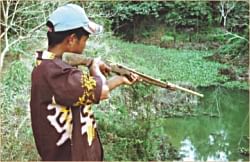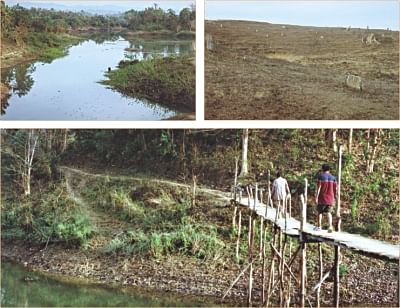In the mild afternoon sun, we wanted to take a better look around. to feel the changes that have taken place since Guy Mountfort, the famous wildlife expert and WWF trustee, visited this place and recorded his fantastic observations. But even before we set out we knew not much of the forest is left today: the land has gone through a lot of stress by humans -- first by building the Kaptai dam that had flooded and destroyed the forest land, and secondly, by illegal loggers.
Mountfort in his book had observed both sides of the forest -- its lushness and its gradual decline. In one place of his book, he wrote: "The vegetation was lush and colourful. Exquisite butterflies were feeding on the white, jasmine-like flowers. ....we began to see large tracts of untouched forest, towering to a great height and densely interwoven with impenetrable vinews which cascaded in vivid green right down to the water." And then he recorded the onslaught of Kaptai dam which was then just completed. "While crossing the main part of the lake, which was so large that we could not see the opposite shore for more than an hour. Presently, ahead of us, a vast expanse of huge dead tree skeletons appeared, standing gaunt and white on the horizon, drowned by the flooding."
We found no trace of Kaptai assault after so many years, or maybe we were unfit to find it after so many years; but works of illegal loggers were everywhere. We entered a sal forest and walked through it. The fallen winter leaves crunched under our feet, creating a monotonously loud noise in this total stillness. We saw stumps of trees, scores of them in every few square feet, like the fallen bodies of soldiers in a war field -- the work of the loggers.  The forest is more of undergrowth today than trees. Huge teak leaves, almost looking prehistoric, glided down the lofty branches making loud murmurs: they sounded like the sighs of a vanishing forest.
The forest is more of undergrowth today than trees. Huge teak leaves, almost looking prehistoric, glided down the lofty branches making loud murmurs: they sounded like the sighs of a vanishing forest.
The density of the forest is varied. At some places it was denser, and at other points it thinned out. There you could see the distant hills -- blue and still -- creating a breathtaking landscape. We reached a wide canal and crossed a rickety bamboo bridge to reach the hill on the other side, circled it a few times to reach the edge. It is most likely here, as Mountfort's descriptions indicate, that he met a raging gayal. The encounter was fascinating. "With no warning at all, our guides stood aside, pointing -- and then melting into the trees, leaving us face to face at sixty paces with two magnificent Gayal bulls....both bulls evidently caught our scent, or heard our shutters clicking. Throwing up their heads, the snorted and charged straight at us, thundering along the trail like express trains." Mountfort escaped harms by his quick action to jump into a ditch. Today the gayals have vanished from the forest as have the white winged wood duck, a globally endangered species.
"It may still be there in the sanctuary," said a forester.
"Sanctuary? Where is that?" Khosru asked.
"Yes, we have one. But I had never been there because it is risky," the reply came. "Sometimes when the army goes there on patrol, the forest department officials accompany them. The UPDF men control that area. The forest is denser there."
But a little later, another forester came up with a different version.
"We have no idea how good is the forest there. We haven't visited that place in a long time. What I have heard is the UPDF people are cleaning up the place."
"But why this place is so depleted? Why don't you go for fresh plantation?"
The forester smiled sadly. "We can't. The UPDF men object to any plantation. They think any development programme will take their right off the land."
And you can't blame the indigenous people after the Kaptai thing and what we saw a little later. Mountfort had described his meeting with the indigenous people in the following sentences: "The smiling Chakmas in the village gave us cheerful greetings. We inspected their decorative earthenware pots and intricately woven baskets."
But today we found very little indigenous settlements here. Those who were still there glanced at us with deep suspicion. They looked distressed in their rundown huts. We tried to strike a conversation with one Chakma family. But they just grunted and murmured in unintelligible Bangla -- their lack of interest showing in their droopy eyes.
We crossed a hill and met two Chakma boys aiming a wooden gun-like catapult at a pond. A sharp arrow was attached to it with a strong rubber band.
"What are you doing with it?" I asked.
"Hunting fish," the elder one replied without taking his eyes off the mark of the gun. His finger ready on the trigger. We patiently waited with him to see his hunting skill. Ten minutes later, he suddenly released the trigger and the arrow shot like a bullet. We saw a silver fish writhing in pain in the water, blood trickling from its upturned belly.
The boys whopped down the slope and hauled up the eight-inch fish.
We moved on. Another hill. Another settlement. Another story. This was a Bangali neighbourhood. The first man we met had settled down here only a few years ago when the government declared parts of the forest land as human habitation. The indigenous people used to live here before. But now only the Bangalis rule.
It seemed we had reached the end of the journey when the sun was about to set. We were standing on a hill. After that a vast lake lay still, the last rays of the day streaking on the water in iridescent colours. The distant hills had turned orange before dimming into blueness. We watched the world immerse in darkness.
*********************************
 We sat in the bungalow balcony and tried to feel the loneliness of the place. This is the first time anyone had stayed a night here because, as the forest officials said, one will run the risk of being abducted by the UPDF. We assured them that no kidnappers would come near us.
We sat in the bungalow balcony and tried to feel the loneliness of the place. This is the first time anyone had stayed a night here because, as the forest officials said, one will run the risk of being abducted by the UPDF. We assured them that no kidnappers would come near us.
So here we were, glasses in hand, listening to the night waking up with all its secrets. First a gecko, the Tokey, began its evening incantation -- a quiet chuckling, followed by a loud 'Tokkay, Tokkay'. Fruit bats woke up from their daylong slumber and lazily flapped across the sky. The dark turned a shade deeper and barn owls announced their presence with sharp squeaks. We could feel their wings beating against the night. And the lonely forest owlet hummed, it was sitting somewhere near, but its dulcet call seemed to be floating in from an unknown distance. Then the nightjar started its mysterious chirping: somebody once told me that when one hears the nightjar's calls great harms come to him. What more harm can come to this forest that hears the nightjar every night? Or to us: the more mundane, the insignificant?
The forest insects had come alive: their collective chirping sounded like a church organ. The night stretched on with more night souls stirring up. Something moved in the bush nearby: maybe a jackal or a civet still trying to hang on to the wilderness.
As the witching hours approached, a mystic thing happened. A big moon rose and the whole forest was washed by its light. A full moon is ageless; we have seen it from the forest so many times. But this was something different. In the pale sky, the moon stood still with a huge halo. A distinct white line marked the end of the halo. We watched it in amazed admiration.
A moonlight night in a forest always makes me feel lonely. It gives the feeling of isolation and insignificance. Pain and sorrow. Nothingness and blues.
You can only watch the silhouettes of the beings and non-beings.
4 









 The forest is more of undergrowth today than trees. Huge teak leaves, almost looking prehistoric, glided down the lofty branches making loud murmurs: they sounded like the sighs of a vanishing forest.
The forest is more of undergrowth today than trees. Huge teak leaves, almost looking prehistoric, glided down the lofty branches making loud murmurs: they sounded like the sighs of a vanishing forest.  We sat in the bungalow balcony and tried to feel the loneliness of the place. This is the first time anyone had stayed a night here because, as the forest officials said, one will run the risk of being abducted by the UPDF. We assured them that no kidnappers would come near us.
We sat in the bungalow balcony and tried to feel the loneliness of the place. This is the first time anyone had stayed a night here because, as the forest officials said, one will run the risk of being abducted by the UPDF. We assured them that no kidnappers would come near us.